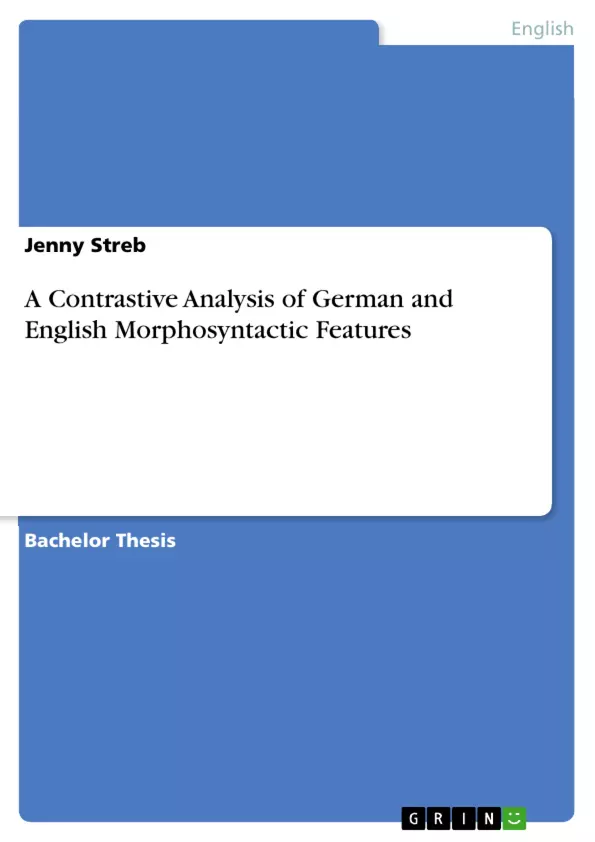In this thesis, the accuracy of the Common European Framework of Reference for Languages (CEFR) is explored with the help of a study investigating the German L2 morphosyntactic competence of 15 English L1 speakers in two settings: a language assessment test setting as well as in online processing.
Within this thesis L2 morphosyntactic competence was limited to the two investigated areas of subject-verb-agreement (SVA) as well as the distinctive verb placement in German main and subordinate clauses. Previous research has identified these two linguistic areas as being especially prone to error in adult L2 acquisition of German. Since all test takers varied in their German language proficiency levels (encompassing a range from A2 to B2 according to the CEFR) it was hypothesised that L2 learners of a B2 language proficiency level generally outperform L2 learners of a lower language proficiency level (B1 and A2) in all investigated areas. However, this hypothesis could not be affirmed since the study did not find significant differences in the morphosyntactic competence of English German L2 learners between test takers of distinctive CEF language proficiency levels.
Inhaltsverzeichnis (Table of Contents)
- 1. Introduction
- 2. Theoretical Background
- 2.1. The Common European Framework of Reference for Languages
- 2.2. Theories about the Origin of Cross-Linguistic Differences
- 2.2.1. The Generative Approach: Universal Grammar and the Principles-and-Parameters Theory
- 2.2.2. The Cognitive Approach: The Competition Model
- 2.3. Characteristics of Verb Placement and Subject-Verb-Agreement in German and English
- 2.3.1. Subject-Verb-Agreement in English and German
- 2.3.2. Verb Placement in English Main and Subordinate Clauses
- 2.3.3. Verb Placement in German Main and Subordinate Clauses
- 2.3.4. Underlying Syntactic Structures
- 3. Hypotheses and Variables
- 3.1. Variables
- 3.2. Hypotheses
- 3.2.1. In the Setting of the LiSe-DaZ test
- 3.2.2. In the Setting of Spontaneous Speech Production
- 4. Design of the Study
- 4.1. Participants
- 4.2. Materials and Methodology
- 4.3. Limitations
- 5. Results: Disclosing the L2 Competence by Analysing German and English Morphosyntactic Features
- 5.1. Realisation of Subject-Verb-Agreement
- 5.2. Realisation of Verb Placement in German Main and Subordinate Clauses
- 6. Application to Second Language Assessment Testing
Zielsetzung und Themenschwerpunkte (Objectives and Key Themes)
This thesis explores the morphosyntactic features of German and English, focusing on subject-verb agreement and verb placement. The main objective is to contrast the similarities and differences in these areas and analyze how they are acquired by second language learners of German. The study aims to contribute to the understanding of second language acquisition processes and provide valuable insights for language assessment testing.
- Cross-linguistic differences in morphosyntactic features
- Second language acquisition of German morphosyntax
- Subject-verb agreement and verb placement in English and German
- Analysis of learner errors and developmental stages
- Implications for language assessment testing
Zusammenfassung der Kapitel (Chapter Summaries)
The first chapter introduces the topic of the thesis, outlining its objectives and research questions. Chapter 2 provides a theoretical background, discussing the Common European Framework of Reference for Languages and theories about the origin of cross-linguistic differences, including the Generative Approach and the Cognitive Approach. Chapter 3 outlines the hypotheses and variables investigated in the study, focusing on the realization of subject-verb agreement and verb placement in different settings, such as the LiSe-DaZ test and spontaneous speech production. Chapter 4 describes the design of the study, including the participants, materials, methodology, and limitations. Chapter 5 presents the results of the analysis, revealing the realization of subject-verb agreement and verb placement by second language learners of German at different proficiency levels. The chapter also includes an analysis of learner errors and developmental stages. Chapter 6 discusses the application of the findings to second language assessment testing.
Schlüsselwörter (Keywords)
This thesis focuses on the areas of second language acquisition, morphosyntax, subject-verb agreement, verb placement, German as a second language, language assessment testing, LiSe-DaZ test, learner errors, developmental stages, Universal Grammar, Competition Model, Principles-and-Parameters Theory, Common European Framework of Reference for Languages.
- Arbeit zitieren
- Jenny Streb (Autor:in), 2017, A Contrastive Analysis of German and English Morphosyntactic Features, München, GRIN Verlag, https://www.grin.com/document/432054



